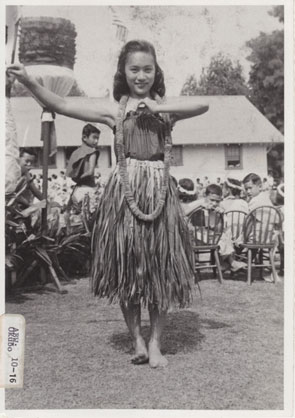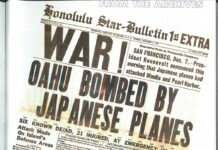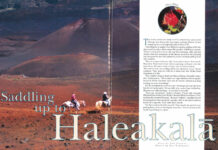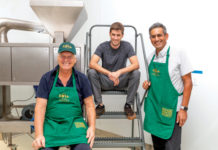Story by Jill Engledow
 On August 21, 1959, with bells ringing and fireworks exploding, the Territory of Hawai‘i became a state. Since then, Maui has changed from a quiet, little-known island to a bustling destination whose name has achieved an international cachet. In these pages, we offer a glimpse of the Maui that was, an island in waiting, about to experience rapid growth and enormous transformation.
On August 21, 1959, with bells ringing and fireworks exploding, the Territory of Hawai‘i became a state. Since then, Maui has changed from a quiet, little-known island to a bustling destination whose name has achieved an international cachet. In these pages, we offer a glimpse of the Maui that was, an island in waiting, about to experience rapid growth and enormous transformation.
In 1959, sugar and pineapple occupied most of the island and its workers. Lahaina was a sleepy backwater town of just over 3,000 people, while cane fields and kiawe trees bordered the pristine and nearly deserted beaches of Ka‘anapali, Wailea and Makena.
Though that pastoral environment might seem a paradise compared to the urbanized Maui of 2009, things were a bit too quiet for local business and community leaders. With increasing mechanization, jobs were becoming scarce, and many high school graduates left the island in search of opportunity elsewhere.
Plantation camps that had once housed thousands began to disappear. The first increments of “Dream City” offered many ordinary Mauians their first chance at home ownership, and families eagerly moved into the new planned community of Kahului.
Shoppers from around the island flocked to Kahului Shopping Center, the first mall-like shopping facility west of the Mississippi.
Tourism seemed the best answer to Maui’s economic problems. American Factors announced plans for the Neighbor Islands’ first major resort at Ka‘anapali. Matson Navigation purchased 1,500 acres of potential resort land in Makena. And in the years to come, Kïhei’s sunny coastline would fill with condominiums.
Statehood brought Hawai‘i to the nation’s attention just as the first jet flights arrived in the Islands. Tourist visits to Maui jumped to 39,000 in 1959, a 50 percent increase over 1958. The boom was about to begin.
Our thanks to those who graciously shared more memories and historical photos than we had pages for: Wayne Tanaka, Friends of Old Maui High School, Maui Land & Pineapple Company, A&B Sugar Museum, Maui Historical Society, Kenji Kawaguchi, Nancy Mawson, Andrew Kutsunai, Emi Azeka and Stephanie Ohigashi. Special thanks to Gail Ainsworth, whose index to The Maui News makes much of Maui’s twentieth-century history accessible.





